INTRO:
In 2010, Alien Swarm debuted on Steam as a honey-pot of sorts. It is a completely free game, complementary to anyone who decided to hop onto Valve’s signature platform. It was also surprisingly fun, which was perhaps to be expected since it was based on a radical Unreal Tournament 2004 mod that was well received by anyone who played it.
That was a long time ago, of course. Valve has changed a lot since then. Due to its some of its less well-received decisions, some of the goodwill that it has managed to garner through its revolution of the gaming scene back in the previous game has petered off, thus hurting the prospects of this game. Alien Swarm’s content and technical support also dried up rather quickly in late 2010, ending with the release of its SDK package; releases of SDK packages very much signify the end of any official development.
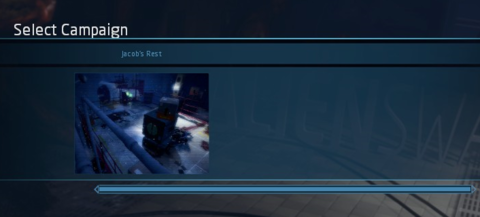
STILL AVAILABLE ON STEAM:
When the Reactive Drop rebuild was announced and released, every Steam user that has already listed Alien Swarm among their games have this list entry updated to Reactive Drop automatically.
Curiously though, the original Alien Swarm is still searchable and playable on Steam. There is little reason to return to it, other than to see how inferior that the original build is, and how disappointing its long-term prospects were.
MUST HAVE STEAM, OF COURSE:
Having been the poster-boy/girl for how “awesome” the Steam platform is, and the fact that it uses the Source game engine as a coding base, it was unsurprising that Alien Swarm requires Steam to play. Back then, Steam was not that intrusive and bent on coding updates that can disrupt and delay the playing of games. Thus, it was not so much of a big deal.
Also, likely due to its status as a freely available game with no paywall of any kind, there were few attempts to pirate the game. (There are such attempts of course, though they would run into a problem regarding the game’s progression system, as will be described later.)
PREMISE:
Alien Swarm does not have much of a story, or at least an original one. Its setting is a generic sci-fi future where humanity has expanded beyond Earth and are only just learning about the wonders and terrors among the stars. This setting has been around since the first Alien film, and perhaps even longer.
Again, not unlike the first Alien film, there is a corps of soldiers that have been tasked with dealing with violent discoveries of the aforementioned terrors and mishaps with scientific discoveries. Yet again, like Alien, the foremost of these terrors are swarms of seemingly monsters that breed at prodigious rates (typically by consuming other living things) and can quickly overrun any human installation.
Of course, the player takes on the role of one of these soldiers. Putting one’s life on the line to salvage whatever or rescue whomever the alien bugs did not consume and then torching the entire place is hazardous, but it’s still a job.
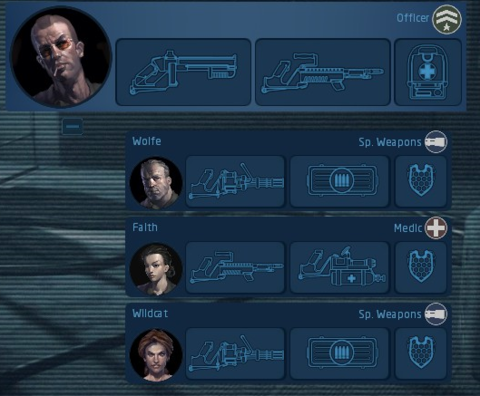
THE PLAYER CHARACTER - OVERVIEW:
The player character uses guns, so ammo is always a concern. Restocking ammo is a priority throughout any mission, because there are nigh-infinite aliens to shoot at. (There are no guns with regenerating ammo, rechargeable packs or some other sci-fi physics-bending gimmick – but there is a chainsaw.)
Of course, the player character is all too capable of dying. Each soldier has a health bar, which diminishes as he/she takes damage. If a soldier is mobbed by a bunch of monsters, he/she is quite doomed. Fortunately, a badly wounded soldier performs at the same level as he/she would be when he/she is unhurt, but it is generally in the player’s interest to heal him/her as soon as possible because there is nothing that can bring back a dead soldier during a mission.
In addition to guns, a soldier has equipment that is intended to give him/her a bit more of an edge. This can be something that provides a bonus as long as it is equipped, or consumed to give him/her a temporary edge. Some maps have equipment lying around, though often out of the way and thus putting the player at risk of being cornered if he/she goes after them.
NUMBER OF SOLDIERS AND NUMBERS OF ENEMIES:
The player character is generally part of a team, unless the player decides to have him/her go alone. If he/she goes alone, the player character risks having no support for dangerous moments such as when reloading guns. On the other hand, the player benefits from a certain balancing mechanism that will be described shortly.
The number of monsters that would come after the player is dependent on the number of soldiers in the team. If the player character is all alone, the monsters come at just a trickle.
If the team numbers at the default four, the aliens come in a stream that can be overpowering if the team is not laying down adequate covering fire.
TYPES OF SOLDIERS:
As mentioned earlier, the soldiers usually come in teams, and teams are typically composed of members with different roles so that the team is prepared for many kinds of scenarios. That said, there are four types of soldiers: the officer, the medic, the fire support (or heavy weapons specialist) and the engineer.
The presence of the officer increases the survivability of every team member, as long as he is close to them. Otherwise, the officer does little more than add to the team’s firepower (though he does have the team’s greatest firepower when on the move).
The fire support specialist’s signature weapon is a rapid-firing big gun; any competent player would make certain that the fire support specialist is always armed with at least one big gun. This is necessary, because the fire support can single-handedly lock down an avenue of approach as long as he/she has ammo remaining in the current magazine.
The medic keeps the team alive, as to be expected. Actually, any other team member can carry healing kits around to heal themselves or the others. Yet, somehow, the medic can eke out a bit more from any healing supplies, thus making the medic more efficient than any other soldier at restoring hitpoints.
The engineer (or “tech”, to use the game’s own terms) is a must-have member, if only because the engineer is the only one that can use computers to remove obstacles that are in the team’s way or to complete objectives. Otherwise, anyone can do what the engineer can do, albeit at a lower level of efficiency.
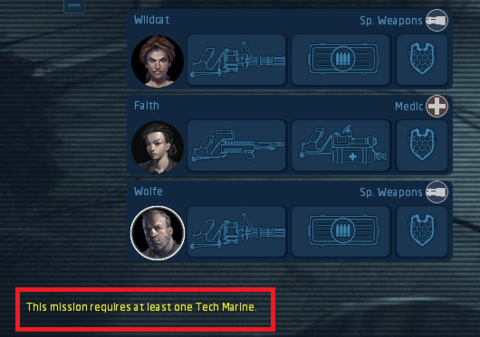
SOLDIER STATISTICS:
Each soldier has a set of statistics that determine their performance and durability in combat, as well as efficiency in their designated role. Some statistics are unique to specific types of soldiers. For example, the officers have the leadership stat, which determines the bonus to combat performance that they confer to their team-mates when they are near.
TWO OF EACH:
The aforementioned statistics are also used to implement named soldiers. There are eight of them, and each is meant to cater to certain playstyles.
For example, there are Wildcat and Wolfe, both of whom are fire support specialists. Wildcat is substantially more mobile, allowing her to keep up with the team even when firing her big gun. Wolfe is a lot more efficient in using big guns, but trades away his mobility for this advantage.
In any game session, any named character can only be picked once. Therefore, there can only ever be a maximum of two soldiers of any type. This is just as well, because otherwise most players would go for a team that is loaded with medics and fire support specialists.
ROLE-SPECIFIC GEAR:
There are some pieces of gear that are only available to specific types of soldiers; these are often guns, and they happen to further emphasize the role of the soldiers too. The chief example of this is the big gun that the fire support specialist has. The big gun is often the only gun that can handle hordes of incoming monsters without having to reload, so stemming the tide is the role of the specialist.
Generally, any unique piece of gear that a soldier gets would serve his/her role, rather than changing it. There may be subtle deviations, like the support specialist’s minigun being more suitable at gunning down wide hordes than shooting down narrow corridors.
ONLY ONE OF EACH TYPE OF GEAR:
Before the start of any mission, the player can pick the gear for the soldier that he/she would use. Each soldier can have two guns and the magazines for them, or two resupply kits, or any combination thereof. The soldier can also have one auxiliary device. There are only ever these, so the player might feel that the options are limited at times. On the other hand, what the soldiers have are usually enough for the mission, if the players are careful. Equipment and supplies are not retained from mission to mission, by the way.
Any soldier can only ever have one of any kind of gear too, e.g. a soldier cannot have two of the same kind of gun. This limitation is especially important for the medic, who cannot refill any healing device that he/she is equipped with during the course of a mission.
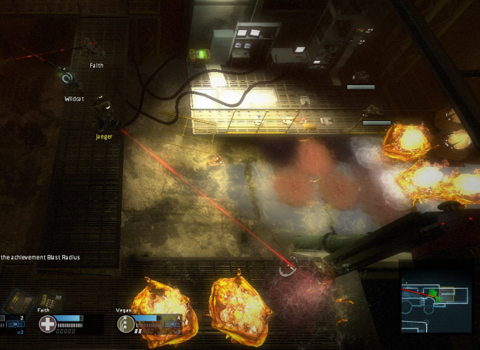
NO MAGAZINE OR LIMITED MAGAZINES:
Some guns, such as the standard issue rifle, the shotguns and other “small arms”, allow soldiers to carry up to five spare magazines for each of them. Some other guns only allow one or two magazines, supposedly because of their size or complexity. This is the case for the big guns carried by the fire support specialists.
Some other guns do not have magazines at all. They have a high capacity, but that is all that their wielder gets. An example is the healing “gun” for the medic. In the case of these guns, there is no resupply for them at all during the course of a mission.
NO SHARING OF MAGAZINES FOR THE SAME GUNS:
The magazines for any gun are only ever unique to that gun, even if another soldier is carrying the same kind of gun. Therefore, the soldiers cannot share magazines with each other.
Granted, even in most present-day team-based shooters, it is still impossible for team-mates to share magazines with each other; the complexity of the coding that allows this to happen is too much for most programmers of such games.
ALTERNATE-FIRE:
Most weapons have alternate fire capabilities. For example, the standard rifle can launch explosive grenades, which are effective against hard targets such as the mortar bugs. The secondary fire of most guns draws from ammo reserves that cannot be replenished, so the player should be prudent in knowing when to use these. Some other guns, such as the Flamethrower, have secondary fire that consumes the same ammunition as the primary fire. The player should be no less careful with these, because the primary fire is often the weapon’s main means of offense.
SWAPPING GUNS & GEAR:
Certain maps have guns and other gear lying about, waiting to be picked up. They are often out of the way, thus requiring the players to risk extending their stay in infested environments for these goodies.
On the other hand, the only reason to ever go after them is that the players have not been conservative in their use of ammunition and other consumables. A team that has been more careful is not likely to ever need them, especially if they know the upcoming challenges and have planned ahead.
If a team needs these spare supplies anyway, they have to swap out their existing gear for them, preferably guns that are running low on magazines. If they have empty slots though (likely due to over-expending their stuff), the spare items go into these.
Soldiers that are killed in action also drop their gear. However, it is likely that the situation has gotten so dire such that taking time to scavenge from the fallen is not a wise decision.
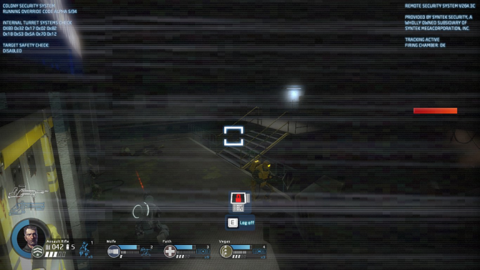
RELOADING MAGAZINES:
Guns that can be reloaded require time to have their magazines changed. This process is shown in a meter that appears over the icon for the team member that is reloading. The meter has a very small section that is highlighted. Pressing the reload button again stops the pointer at anywhere that it currently is on the meter.
Experienced players may recognize the aforementioned section as the spot that the meter pointer should stop at, in order to accelerate the reloading process. Failure to stop the pointer at exactly the highlighted section causes the reloading process to take longer, as indicated by animations that show the soldier fumbling.
For most guns, replacing their magazines causes any remaining rounds in the previous magazine to be completely discarded. Anal-retentive players would want to make sure that every shot counts, but wiser ones know that it might be smarter to have a fresh magazine just before the proverbial turd hits the fan.
Some other guns have no such issue. These guns happen to run on batteries, and any reloads happens to charge them, partially or fully (to the max capacities of these guns). Full charges might waste spare charges, but partial charges certainly do not.
MAGAZINE RESUPPLIES:
In addition to whatever spare magazines that a soldier has, he/she can carry around an ammo resupply kit too. It looks like a box when it is deployed, but somehow the kit can provide ammunition to just about any weapon, including even battery-powered guns.
However, the kit can only resupply so much. Its remaining supplies are shown as a bar underneath its model. Resupplies for small arms take away a unit of supplies for each magazine that is retrieved, but other weapons gobble more. In particular, the big guns of the fire support specialists gobble an entire kit’s worth of supplies.
Some maps do have already deployed ammunition kits lying around, often conveniently before a particularly shoot-happy section. If not, then there would be unused kits lying around instead.
GUN-SPECIFIC RESUPPLIES:
The team may also come across kits that resupply specific weapons. This is usually a hint that these are weapons that are useful for the missions whose maps that they appear in.
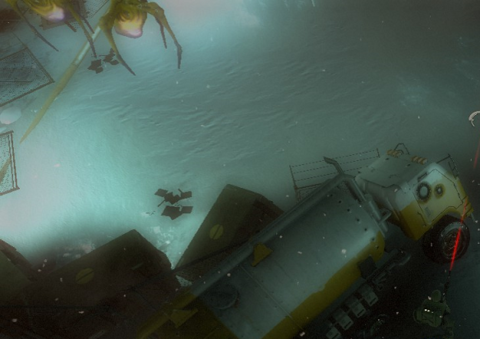
ALTERNATIVE GUNS:
Some guns are unique to specific types of soldiers, as mentioned earlier. However, there are some guns that anyone can use. This includes the standard rifle, which is the default gun that anyone has.
There are also other kinds of guns, which a soldier can carry instead of his/her class-unique guns. Doing so is not recommended in the case of the fire support specialist, but any other soldier, even the Officer, may benefit from having some other gun instead of their class-unique guns.
The benefit that can be obtained greatly depends on the player’s preferred playstyle and skill with that playstyle, however. For example, the precision rifle is best in the hands of a player with considerable hand-eye coordination (i.e. “twitch” skill), and who knows which monsters are best hit with its powerful rounds.
Otherwise, any player is better off having the default rifle instead. If the player wants to make use of the alternative guns, the player should learn about the situations in which they are most useful.
PROGRESSION SYSTEM:
Speaking of learning, there is a progression system in place that prevents the player from having all pieces of gear available for use right from the start. It might seem contrived at times, but in hindsight, this was perhaps for the better. Some gear pieces, such as the aforementioned alternative guns, are best placed in the hands of an experienced player who can recognize the utility of situational items in specific scenarios.
This progression system makes use of experience points (XP) and levels – so far, so familiar. The player is awarded XP upon completing a mission. The amount earned depends on the player’s performance. The completion of objectives and kill scores are the biggest factor, but minimizing friendly fire incidents is also important. When the current XP meter is filled, a level is earned, and if there is an item that has to be unlocked by achieving a certain level, it will be.
LEVEL RESETS:
After achieving a certain level (27, in the case of the base game), the player can choose to reset the level of his/her user account for a “prestige” distinction. In online sessions, other players can see this distinction. Ideally, they would be convinced about the player’s experience with the game when they see the distinctions.
However, other players might be more concerned about the player’s current level instead, because the level determines the amount of equipment that they have unlocked. In particular, they may not be entirely okay with players that have yet to unlock the medic’s unique healing equipment.
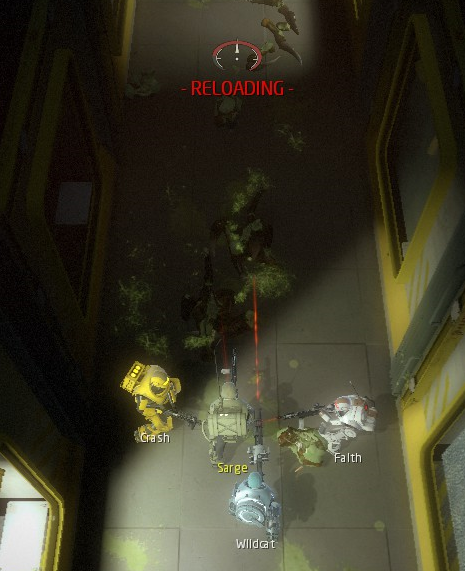
CANNOT EXCHANGE GEAR, BUT CAN DROP IT:
Interestingly, a player can choose to have his/her soldier drop his/her currently-wielded gun with the press of a button. This allows other soldiers to pick up that gun, as long as their class can use it. This allows player characters to exchange guns, albeit indirectly.
This is handy, if team members decide to change roles during a mission. On the other hand, if the team has to resort to doing this, this means that someone in the team has screwed up his/her job.
DEPLOYABLE MEDKIT:
In addition to the deployable ammo resupply kit, there are deployable medkits. These project fields that heal any soldiers that happen to be under them. The fields will eventually collapse in time, or after having healed a certain number of hitpoints, totalled across all soldiers. This is important to keep in mind, because these kits are precious things that also happen to take up entire weapon slots.
HEALING GUN:
The player eventually unlocks what is practically a “Healing Gun” for the Medic. It has an actual official name, but it is a mouthful to say and tedious to write. Also, it is obviously patterned after the medi-gun in Team Fortress 2, another Valve game. The gun’s healing beam even bends.
Prior to a certain update, the Healing Gun can end up wasting its shots if the player is aiming at thin air instead of a soldier. This has since been fixed; it only fires if the cursor detects a valid target. The gun also stops ‘firing’ on a soldier that has already been fully healed.
The player can have the Medic heal herself/himself by aiming the targeting cursor on the model of the Medic. There is barely any healing beam that can be seen, consequently, but the medic’s rising health should be an indicator that the healing works. This convenience is due to the object-sensitive aiming, which will be described later.
SENTRY GUNS:
Sentry guns are portable turrets that the soldiers can deploy to help them cover places while they concentrate on other places. Sentry guns also have powerful weapons that pack bigger wallops than even those carried by the fire support specialists, thus making them useful for occasions when the team has to face an onslaught of enemies. There are many such occasions in the official campaign, so having sentry guns for them is a good plan.
AUXILIARY GEAR:
Auxiliary gear can be something as simple as extra armor or a personal healing kit. It can also be a trump-card item, such as a portable missile silo that can somehow fire off micro-missiles without any injury to their wielder. It can also be something that helps lock down a place better, such as proximity mines. However, any auxiliary gear other than extra armor or the health kit tends to have highly situational uses, making them useful only to experienced players who know what’s up ahead.
There are some special auxiliary gear that can only be found in certain maps. For example, there is the Blink pack; MOBA game veterans would recognize it as a short-ranged teleportation device.
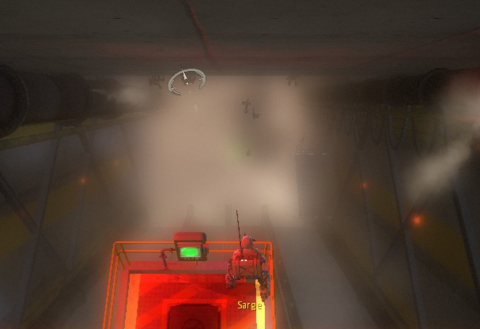
MELEE ATTACKS:
In lieu of using a soldier’s gun, the player can have him/her make melee attacks instead. Indeed, the soldiers’ melee attacks are quite hefty, likely due to the augmentation provided by their powered armor. Each punch or kick can obliterate a regular swarm drone outright on the default difficulty setting. However, chaining together consecutive melee attacks such that they are all effective can be challenging to pull off. If the player messes up, the aliens would just hit his/her soldier while he/she flails uselessly.
Amusingly, if a soldier happens to be equipping one of the deployable kits at the time, the soldier simply brings the kit down on an enemy’s head. There is no difference in the animation speed or damage dealt, however.
ROLL:
A soldier can roll in any direction. If the soldier is rolling past or away from an attacking monster, the monster’s attacks hit air. Also, as to be expected of rolls in video games, rolls somehow grant invincibility frames against certain incoming attacks. For one, a soldier can roll across the field of fire of the other soldiers without much of a problem. However, a soldier cannot roll past any character, be it soldier or monster; the soldier simply completes his/her rolling animation in front of the obstructing character.
CROUCH:
Most of the time, the team is better off staying mobile, always moving from one objective to the next while covering each other. However, there are occasions where they have to hunker down, such as the aforementioned scenarios when the team should deploy any sentry gun in their possession. In these scenarios, some team members, especially the fire support specialists and anyone with high-power guns, should maximize their efficiency at shooting – simply by crouching.
There is generally no other reason to crouch though. The soldiers cannot move so well (if at all) while crouching, and there are no obstacles in the game that they have to duck under.
OBJECT-SENSITIVE AIMING:
The player can always see where his/her soldier is aiming, thanks to both the laser sights emitted by their guns and the targeting cursor. The targeting cursor is particularly important for the act of aiming.
Any object that the cursor falls on, especially if it is the model for a soldier or a monster, becomes the target of the aiming automatically; the player can confirm this by looking at the laser sight, if it is visible, or the arms of the soldier. Any shots that the player fires during this fly towards the target.
This is useful in certain situations, such as aiming at incoming drones that are climbing walls or crawling across pipes on the ceiling. It is useful when the player needs to shoot at fuel barrels too.
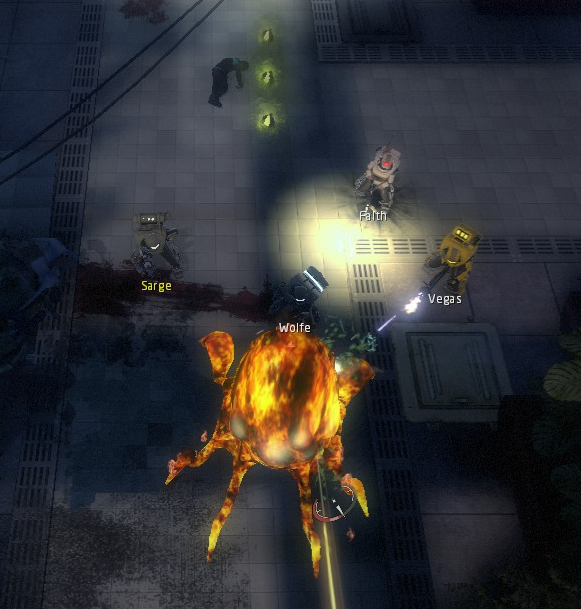
THE BUGS – IN GENERAL:
The aliens – simply called “bugs” by anyone who is voiced – are stupid but relentless. They spawn into the map continuously, often near the team. Experienced players might recognize some of the scripting behind the spawning, especially if they remember the Left 4 Dead games.
People who are well versed in the tropes of the Alien movies would recognize where the bugs appear from too. Grills on the floor, the ceiling, windows, cracks in walls and the likes are places through which the bugs gain entrance. The bugs are vulnerable when they perform the animations for gaining entry into the mission area, so the player could kill them before they become active threats.
As for the types of bugs, the most common are the drones. These often come in the titular swarms; more often than not, as long as the soldiers are firing in their general direction, each shot is going to hit one of them. They actually hit quite hard, but they have brief wind-ups to their attacks that can be exploited.
Next, there are the buzzers. As their name suggests, they can fly, often seemingly from off-screen. They are difficult to hit with melee attacks, but are easy to shoot down. More importantly, they often appear together with harder-hitting aliens, so the players have to decide between shooting them down first and dealing with them later.
The drones and buzzers are sometimes accompanied by rangers or boomer bugs, which are the distant third and fourth in terms of commonness. Rangers can fire projectiles across long distances, but they are not very bright in aiming. They are completely unaware of any environmental obstacles in between them and the soldiers, so they waste a lot of their shots.
Boomer bugs have slow, easily avoidable attacks, but they are damage-sponges and take up a lot of space; if the team is not careful, they can end up getting cornered by these bugs. Furthermore, when they die, they scatter organic explosives, which can be painful if the soldiers do not get out of the way in time.
SHIELD BUGS:
These bugs concentrate their carapace armor in their front legs, all of which can be brought forward to be locked in place to form a shieldwall. They can also charge forward while holding up their shield-walls.
Fighting them often requires coordination between team members, because it is nearly impossible to shoot past the armor on their legs. Some team members get their attention (usually by getting close enough that they try to attack), while the others circle around and shoot at their luminescent unarmoured abdomens.
MORTAR BUGS:
Mortar bugs do not move much, but they do not have to; among the bugs with ranged attacks, they have the longest range and can fire their organic bombs just about over anything. They are a serious impediment if the player does not do something about them, but experienced teams of players might attempt to simply outrun their range and bypass them entirely. Besides, they take a lot of damage to go down, and that can be too much ammunition to spend on them.
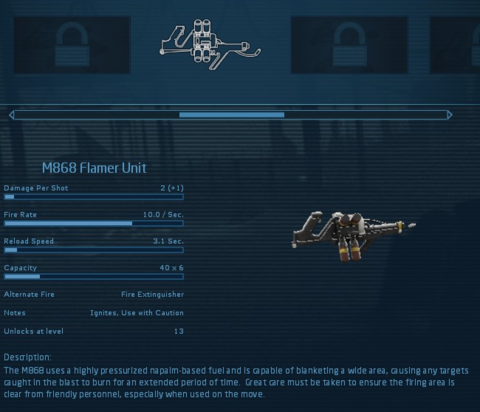
HARVESTER BUGS & XENONITES:
Harvester bugs are large, slow and clumsy, but spawn the diminutive xenonites continuously as soon as they have detected the soldiers. Interestingly, if the soldiers fail to deal with them and attempt to bypass them, the harvester bugs will spawn and gather gaggles of xenonites and move together with them to pursue the soldiers. It can be a nasty scenario if they catch up.
PARASITES:
By far, the worst and most dreaded enemies are the parasites. These resemble the face-huggers from the Alien franchise, crossed with the headcrabs from Half-Life. Obviously, their appearance would suggest that they are bad news. They are not very tough, but they are small enough that the player has to give his/her full attention to shooting them to bits before they can get close enough to pounce and latch onto a victim.
If a parasite manages to latch onto a soldier, that soldier is infected; killing the parasite will not stop this, but does prevent the parasite from continuing to inflict damage through its head-humping animation. The soldier’s health bar appears under his/her model, coloured an alarming red.
The health bar also has a yellow section; as long as the parasite is still attached, the yellow section gets longer. Meanwhile, the infection inflicts damage equal to the amount that the yellow section represents every second. Therefore, getting the parasite off first is important. Fortunately, this can be done with simply shooting or punching the parasite.
Death comes quickly if the infected soldier could not obtain healing from healing fields or the healing gun in time; personal health kits do not help. The appropriate healing source restores the soldier’s health while also simultaneously diminishing the yellow section.
It is for this health loss alone that parasites are much despised. It is not uncommon for experienced players to warn or remind the others about sections of a map that is known to have parasites on the prowl.
EGGS:
The parasites are one of the larval stages of the bugs, so it is understandable that they came from a source of production. This source is the bugs’ eggs.
The eggs are a proximity hazard. If the soldiers get too near, they start to spawn parasites; at that range, all it takes for infection to set in is a single pounce. Fortunately, eggs can be shot from a distance, but they take considerable amounts of damage. Rather, setting them on fire is a better way. Besides, egg clusters on fire prevent any parasites from forming.
BIOMASS:
Biomass is a type of organic obstacle. Somehow, they repulse any soldier that gets too close, thus preventing progress. Biomass is impervious to anything but fire; incidentally, they are rather flammable. It takes a while for them to burn to death on their own, though the player can hurry things along by burning them some more. Wiser players usually go elsewhere to do other things. Incidentally, missions in which biomass appears usually have multiple concurrent objectives.
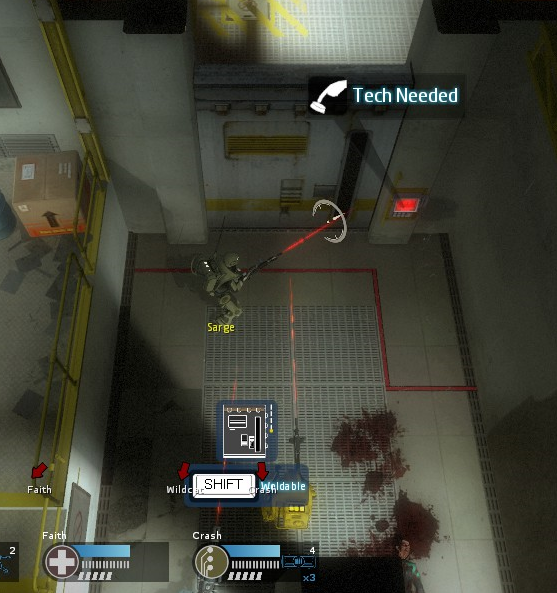
DOORS:
The human installations have doors that are practically motorized bulkheads. Some of them are already welded shut, thus requiring a soldier with a welder to remove the welding in order to progress. Alternatively, the player may also have a soldier weld a door to shut it – likely because there is a gaggle of angry bugs coming down the corridor behind the team.
Doors are not indestructible objects though. Stray gunfire, explosives and bug-mauling would eventually break the doors down.
It is worth pointing out here that unlocked doors will automatically open in the proximity of the soldiers, but not the monsters. The monsters will attack these doors like they would welded ones, but if the soldiers come close, the doors would open and of course let the monsters in.
HAZARDS:
The places that the soldiers go to are either environments hostile to human life, or badly compromised human installations. Most installations in the official campaign are still intact (and canonically still under construction). Most of the things that would hinder the player are mere obstacles such as debris and stacks of materials. However, there are dangerous hazards here and there.
Firstly, there are the stereotypical red fuel barrels standing around, just there to be exploded. They can only be detonated through weapons fire or sympathetic detonations, so if any goes off too close to any soldier, that would be the fault of the player(s). Obviously, they are meant to be used against the aliens, who are simply oblivious to the dangers that the barrels pose.
There are also toxic waste barrels, which release vapours that stun and eventually kill any alien that is stupid enough to move through them. These are rare, however, and that is perhaps for the better: the vapours hurt the soldiers too. However, they will not slow them down.
Fire is the most dangerous of the hazards. The fictitious fires in this game are the kind that do not spread, but burn indefinitely. Obviously, they will injure any soldiers that come too close, and will eventually set a soldier on fire too if the player fails to get him/her out of the way. The aliens are oblivious to fires though. In their hurry to attack the soldiers, they will run through the fire and burn themselves.
The presence of fires in the environment is a cue for the player to look for another way around, or to find a fire extinguisher to put them out. Fire extinguishers occupy slots for weapons and are only ever meant for the putting out of fires. The fire extinguisher would just give the bugs a refreshing breeze, or put out their fires if they are already burning.
Some maps also have falling hazards. Usually, these are easy to avoid. However, some aliens, such as the Shield Bug, do hit hard enough to knock soldiers around, possibly into one of these falling hazards if the players are not careful.
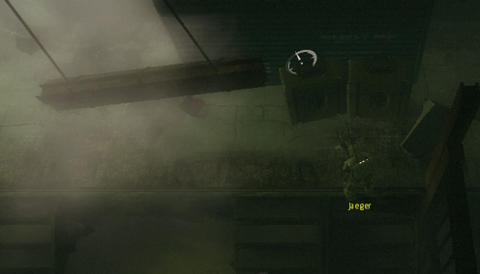
FRIENDLY FIRE:
Friendly fire is always a risk in any mission. The host of a session can set the severity of friendly fire. By default, friendly fire does much reduced damage to other soldiers, but the other setting worsens it. Fire from any flamethrowers or incendiary munitions can set soldiers on fire too, so any player that is controlling a soldier that has these should be particularly careful of where they aim. (The default friendly fire setting makes it difficult for these incendiary weapons to set other soldiers on fire, however.)
ONSLAUGHT:
“Onslaught” is a setting that can be defined before a mission. If enabled, it causes the mission to ignore its monster-spawn scripting in favour of seemingly random spawns. This can get hairy rather quickly, especially if the team comes under attack by a flood of Parasites or tough bugs, or both.
EXTRA CHALLENGE, EXTRA XP:
In addition to the nastier setting of Friendly Fire and the enabling of Onslaught, there is another setting to make things generally more difficult. The players gain more XP from taking on these greater challenges, as well as the opportunity to earn some Steam achievements.
ENVIRONMENTS & MODELS:
Since the game is built using the Source engine, the player should not expect the game to sport anything beyond Direct X11 quality of visuals. Nevertheless, the Source engine has aged quite well, and is more than good enough for the purpose of displaying whatever that matters to the gameplay.
Being a top-down game, Alien Swarm has the player looking at locales, from an eagle’s eye perspective. This is perfectly okay for outdoor areas, but as to be expected, it would seem a bit silly for indoors or underground ones. The out-of-bounds areas, as experienced game consumers would know all too well, are empty spaces of blackness.
The Source engine is no stranger to being used for environments that are spooky and dilapidated. Therefore, that it is used to make colonies on inhospitable planets seems quite appropriate.
Models in Alien Swarm do not have a high number of polygons. This is mostly not an issue in the case of the aliens, which already look inhuman anyway. The low number of polygons is noticeable in the models of the soldiers, however. On the other hand, the soldiers are wearing powered armor, which is sort of a good excuse for their blocky looks.
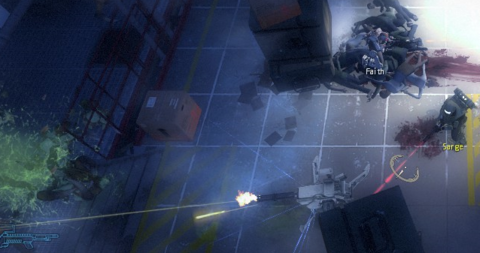
ANIMATIONS:
Again, this being a game made with the Source engine, the animations of its 3D models are the kinds that a long-time game consumer would see prior to the advent of DirectX 12 and its latter-day ilk. The models appear to have some detailed motions like arms reaching towards belts or backs to fetch weapons or (inhuman) legs crouching before a pounce.
However, there is goofiness such as models sliding along the floor or not following appropriate trajectories when they are in mid-air. In other words, the same awkwardness that people might see in amusingly awful G-Mod videos can sometimes be seen in this game too.
Amusingly, burning monsters have animations of their own. The most entertaining of these are those of egg sacs, which appear to squirm violently, as if the parasites within are attempting to escape.
LIGHTING & SHADOWING:
Incidentally, lighting and shadowing effects are some of the easiest things to update over the years. In this regard, the improvement between the 2010 version of Alien Swarm and its 2018 version (and the Reactive Drop rebuild, for that matter) is noticeable. Shadows are smoothly generated and applied onto shaders and textures, and lighting is similarly efficient. This is not something that is unique to this game or the Source engine of course, but it is good to know that the game’s developers had been implementing these.
PARTICLE EFFECTS:
Particle effects are another kind of visuals that the Source engine has managed to keep up with over the years, primarily due to advancements that made them more efficient to produce. In this game, they are used for the fires and gun-fire, which look mostly believable. They are also used for the emissions from alien effluents and assorted loogies; in this case, the particle effects are there to highlight their presence and make them easier for the player to spot and avoid.
CONTEXT-HIGHLIGHTS:
Perhaps the most important visuals in the game are the icons that are overlaid onto thing using the Source engine’s very versatile tools at implementing user interfaces. These inform the player about important things, such as a soldier dying from infection.
TEXTURES:
The textures are perhaps where the game shows its age. Many of them resort to straight edges to avoid losing fidelity. This is acceptable when they are used for what are clearly man-made objects. However, any other textures, such as those for the aliens, just look muddy by today’s standards, even at the highest settings.
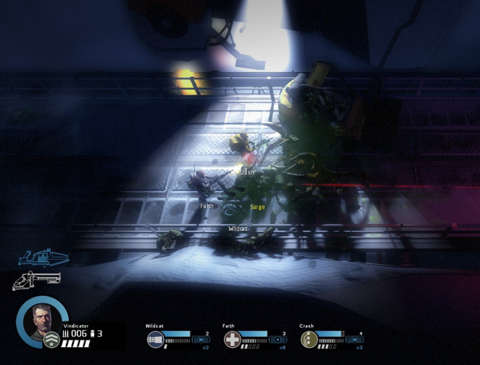
VOICE-OVERS:
Understandably, only the human characters have voice-overs. There is the officer of the Bloodhound gunship, who gives them intel and also provides heavy fire support whenever they are outdoors (or wherever the gunship can fit, really).
Each of the eight named soldiers has his/her own set of voice-overs, which sometimes help the player recognize which soldier might be in trouble, if the player can hear them over the din of combat. The voice-overs also express their personalities, or lack thereof. For example, Faith’s voice-overs lack emotional inflection, though this is perhaps in-line with her cold calmness. Amusingly, the voice-overs are varied enough that there are lines where they address each other by name.
SOUND EFFECTS:
Typically, there is a lot of gunfire to be heard when a team of armed soldiers do their work. Gunfire, of course, indicates that monsters are afoot and within range. The aliens also make a lot of unearthly noises as they fight or stalk the soldiers, which conveniently inform the player that they are still around.
There are ambient noises too, such as spinning fans and humming/hissing machinery. There is also grinding of machinery, which is usually heard when the team has to engage mechanical devices in order to progress while attracting the attention of many monsters.
MUSIC:
Interestingly, the music is set to a low volume by default. This is perhaps just as well, because listening for sounds other than the music is important to the gameplay. As for the music, the soundtracks are archetypically ominous, have unearthly noises and occasionally sound forlorn. In other words, the music is not much of anything new to anyone that has listened to music that has been inspired by Jerry Goldsmith.
The tracks do switch to higher-octane ones during tense set-piece situations. These have more percussion, and some even have techno (these, in particular, are used for escape sequences).
LACK OF SINGLE-PLAYER SUPPORT:
In the original package of Alien Swarm, CPU control for team-mates that are not within the control of a human is only available for the “offline practice” mode, which features only the first two missions of the Jacob’s Rest campaign. If the player wishes to play the rest of the game, the player has to play online, with other players.
This was terribly limiting, and this problem only became worse over time as interest in the game inevitably wanes, even though it is free.
STEAM-CLOUD-ONLY PROGRESSION SYSTEM:
The progression system that has been described earlier is tied to the Steam Cloud system. After all, as mentioned earlier, Alien Swarm was the poster child of the Steam platform, so it utilized the Cloud feature, for better or worse. Its utilization meant that the player could retain any achievements and progress even down the years (as I have discovered), but it also meant that the player has to be online and has to play online sessions in order to accrue any points for progression.
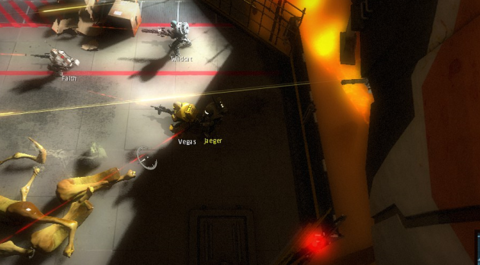
CLOSING WORDS:
It was seven long years in between the debut of Alien Swarm on the Steam platform and its revitalization in 2017. Seven years are enough to look back in hindsight and realize that Alien Swarm was one of those good things that just do not last. That is a cynical view of course; even in its first form, Alien Swarm was sophisticated and fun for a free game, and while it lasted, the game greatly amplified the feel-good euphoria of having hopped aboard the Steam platform back then.

